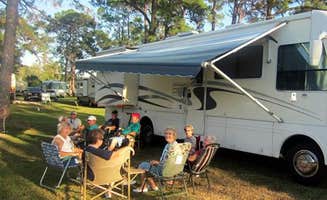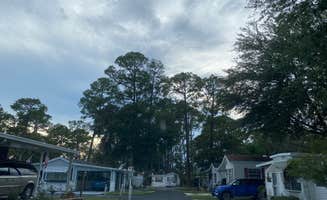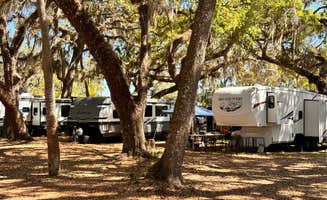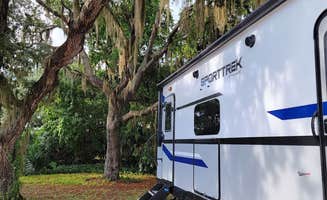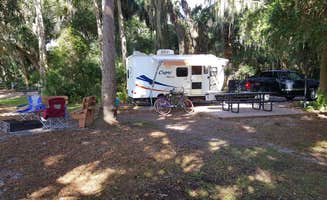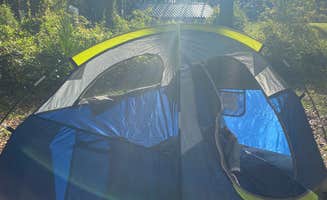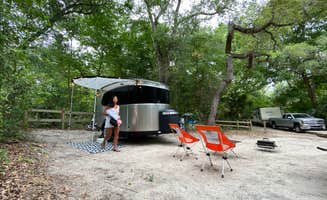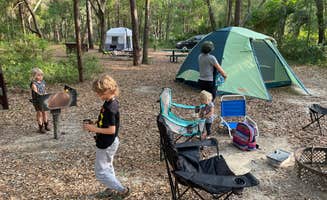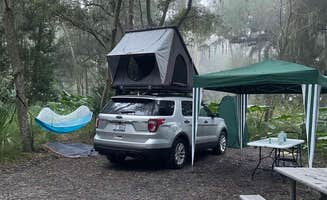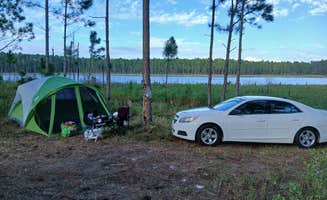Camping sites near Grand Island, Florida range from primitive forest settings to full-service lakeside accommodations. The region sits primarily between 30-100 feet above sea level, creating a terrain that combines sandy soil with a water table that's often just a few feet below the surface. Summer temperatures regularly exceed 90°F with humidity levels above 80%, while winter lows can occasionally dip below 40°F between December and February.
What to do
Springs exploration: Lake County's freshwater attractions offer crystal-clear swimming. At Alexander Springs Recreation Area, the spring head is directly accessible. "The spring head is located right in the swimming area, it's bigger than any swim area at a spring that I have ever been too," notes Gabby C. The water maintains a constant temperature year-round, making it refreshing even in Florida's summer heat.
Paddling: River systems connect many of the region's camping areas. Juniper Springs Recreation Area offers a challenging paddling route. "This is a must do if you are a kayaker. Some of the prettiest water in central FL makes for a great one way downstream 7 mile float. Boats less than 10' greatly improves your ability to navigate tight turns," advises Rebecca E. Boat rentals are available at most springs, with costs typically running $20-40 for half-day rentals.
Wildlife viewing: Seasonal animal sightings vary throughout the year. Visitors to Wekiwa Springs State Park Campground report diverse wildlife encounters. "Saw lots of animals. Everyone was very nice!" says Caitlyn P. The park's diverse ecosystems support everything from wading birds to small mammals throughout its trail systems.
What campers like
Privacy between sites: Some campgrounds offer better separation than others. At Lake Dorr Campground, campers appreciate the natural buffers. "Every campsite has its own little private nook. So it's up to you if your a social butterfly or want to just be anti social," explains Darsea. Sites typically include fire rings, picnic tables, and in some cases, bear-proof storage boxes.
Clean facilities: Bathroom quality varies significantly across camping areas. Trimble Park Campground maintains well-kept amenities. "Restrooms and shower facilities are fairly well taken care of," notes Stuart K. "This is a beautiful and well maintained county park." Most campgrounds in the region offer some combination of restrooms, showers, and dishwashing stations.
Water access: Lakefront sites provide additional recreational options. Many campers value the proximity to swimming areas. "I stayed in site 11 that was positioned so I had a magnificent view of the lake and the little gator that lived at the waters edge. I paddled my inflatable kayak around lake Carlton and the adjoining lake that has the boat ramp. I launched directly from my campsite," shares Ryan S. about Trimble Park.
What you should know
Reservations essential: Competition for sites varies seasonally. The booking process at Trimble Park involves "booking 45 days in advance, so you have to time the precise days you want to camp here and be the first person to reserve a spot at 12:01am on the day that those spots become available," explains Stuart K. Most state parks open reservation windows 11 months in advance.
Wildlife precautions: Bears and alligators require proper safety measures. At Clearwater Lake Campground, "It is an active area for bears so make sure not to leave any food out at night. The campground does have a bear proof box to store some stuff in at night but make sure to put food in containers and in your car if you can," advises Kevin D.
Weather considerations: Camping comfort changes dramatically with seasons. Summer visitors should prepare for intense heat and insects. "Very nice campground, the oak canopy makes great shade in the heat," notes Nicole D. about Alexander Springs Recreation Area. Thunderstorms occur frequently during summer afternoons, with the highest rainfall typically coming between June and September.
Tips for camping with families
Accessibility features: Some parks offer specialized accommodations. Wekiwa Springs State Park provides facilities for visitors with mobility challenges. "Jane, one of the park rangers informed us about the ramp for wheelchairs, and a lift into the water! She was so helpful," shares Lauren W. Most developed campgrounds in the area offer at least some accessible sites.
Swimming options: Natural springs provide safer alternatives to lakes. Children particularly enjoy the designated swimming areas at Alexander Springs. "The swimming area is amazing," says Rusty R. "I have been camping here since I was a kid. I still enjoy camping at this place." Swimming areas at springs typically include both shallow entry points and deeper sections.
Playground availability: Limited options exist for traditional play structures. Lake Griffin State Park offers some recreational facilities beyond water features. "Good trails. Kayaks/Canoes available to rent. Bathrooms and showers were always clean," notes Tee S. Most developed campgrounds include at least basic recreational facilities like open fields or volleyball courts.
Tips from RVers
Site selection: RV-specific considerations affect camping experience. Encore Southern Palms RV Resort uses a unique system for site placement. "One thing that separates them for the other campgrounds is the unique style they have of getting you to your spot. You follow a person to your spot and they then stretch a rope for you to back along to make sure your at the farthest from one side to give both you and the next site all the space allotted to your site," explains Robert M.
Hookup variations: Electric and water availability differs widely. Clearwater Lake Campground offers more primitive options. "No power or water at any of the sites, drinkable water is not far from any site," reports Mike G. In contrast, most state parks provide electric hookups at most sites, though sewer connections are less common.
Size restrictions: Many forest service campgrounds limit RV length. At Lake Dorr Campground, Roger W. advises, "Rig Size: I don't think large Riggs would be appropriate here." Most primitive campgrounds within Ocala National Forest can accommodate RVs up to about 25 feet, while state parks and private facilities can often handle larger rigs up to 40+ feet.


